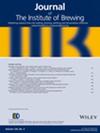下载PDF
{"title":"麦芽品质及酿造过程对啤酒变质醛形成的贡献综述","authors":"Weronika Filipowska, Barbara Jaskula-Goiris, Maciej Ditrych, Paula Bustillo Trueba, Gert De Rouck, Guido Aerts, Chris Powell, David Cook, Luc De Cooman","doi":"10.1002/jib.644","DOIUrl":null,"url":null,"abstract":"<p>Despite decades of extensive research, beer flavour instability remains a challenge for both brewing and malting industries. Malt impacts the brewing process as well as the quality of the final beer. It also affects the stability of beer flavour, as it delivers to the brewing process various compounds with the potential to compromise the desired flavour characteristics of beer. These include staling aldehydes and their precursors, such as amino acids, reducing sugars, α-dicarbonyls and bound-state aldehydes. In general, the content of these compounds depends on barley variety and quality, the malting regime and final malt quality. Malt that represents a low potential for beer staling, <i>i.e</i>. that has low values of Kolbach Index, heat load, colour, LOX activity, Strecker aldehydes, transition metal ions and high antioxidative activity, leads to beer with enhanced flavour stability. However, the consistent production of malt with the desired quality remains challenging. Approaches to achieve this include adjustment of steeping and germination conditions, allowing control of grain modification and thus, the reservoir of aldehydes precursors. Also, the application of alternative kilning technologies may reduce the applied heat load, responsible for the formation of staling aldehydes and triggering development of the oxidising free radical species. This review provides an evaluation of current knowledge on the contribution of the malting process and malt quality to the formation of beer staling aldehydes. © 2021 The Authors. <i>Journal of the Institute of Brewing</i> published by John Wiley & Sons Ltd on behalf of The Institute of Brewing & Distilling.</p>","PeriodicalId":17279,"journal":{"name":"Journal of The Institute of Brewing","volume":null,"pages":null},"PeriodicalIF":2.4000,"publicationDate":"2021-03-30","publicationTypes":"Journal Article","fieldsOfStudy":null,"isOpenAccess":false,"openAccessPdf":"https://sci-hub-pdf.com/10.1002/jib.644","citationCount":"25","resultStr":"{\"title\":\"On the contribution of malt quality and the malting process to the formation of beer staling aldehydes: a review\",\"authors\":\"Weronika Filipowska, Barbara Jaskula-Goiris, Maciej Ditrych, Paula Bustillo Trueba, Gert De Rouck, Guido Aerts, Chris Powell, David Cook, Luc De Cooman\",\"doi\":\"10.1002/jib.644\",\"DOIUrl\":null,\"url\":null,\"abstract\":\"<p>Despite decades of extensive research, beer flavour instability remains a challenge for both brewing and malting industries. Malt impacts the brewing process as well as the quality of the final beer. It also affects the stability of beer flavour, as it delivers to the brewing process various compounds with the potential to compromise the desired flavour characteristics of beer. These include staling aldehydes and their precursors, such as amino acids, reducing sugars, α-dicarbonyls and bound-state aldehydes. In general, the content of these compounds depends on barley variety and quality, the malting regime and final malt quality. Malt that represents a low potential for beer staling, <i>i.e</i>. that has low values of Kolbach Index, heat load, colour, LOX activity, Strecker aldehydes, transition metal ions and high antioxidative activity, leads to beer with enhanced flavour stability. However, the consistent production of malt with the desired quality remains challenging. Approaches to achieve this include adjustment of steeping and germination conditions, allowing control of grain modification and thus, the reservoir of aldehydes precursors. Also, the application of alternative kilning technologies may reduce the applied heat load, responsible for the formation of staling aldehydes and triggering development of the oxidising free radical species. This review provides an evaluation of current knowledge on the contribution of the malting process and malt quality to the formation of beer staling aldehydes. © 2021 The Authors. <i>Journal of the Institute of Brewing</i> published by John Wiley & Sons Ltd on behalf of The Institute of Brewing & Distilling.</p>\",\"PeriodicalId\":17279,\"journal\":{\"name\":\"Journal of The Institute of Brewing\",\"volume\":null,\"pages\":null},\"PeriodicalIF\":2.4000,\"publicationDate\":\"2021-03-30\",\"publicationTypes\":\"Journal Article\",\"fieldsOfStudy\":null,\"isOpenAccess\":false,\"openAccessPdf\":\"https://sci-hub-pdf.com/10.1002/jib.644\",\"citationCount\":\"25\",\"resultStr\":null,\"platform\":\"Semanticscholar\",\"paperid\":null,\"PeriodicalName\":\"Journal of The Institute of Brewing\",\"FirstCategoryId\":\"97\",\"ListUrlMain\":\"https://onlinelibrary.wiley.com/doi/10.1002/jib.644\",\"RegionNum\":3,\"RegionCategory\":\"农林科学\",\"ArticlePicture\":[],\"TitleCN\":null,\"AbstractTextCN\":null,\"PMCID\":null,\"EPubDate\":\"\",\"PubModel\":\"\",\"JCR\":\"Q3\",\"JCRName\":\"FOOD SCIENCE & TECHNOLOGY\",\"Score\":null,\"Total\":0}","platform":"Semanticscholar","paperid":null,"PeriodicalName":"Journal of The Institute of Brewing","FirstCategoryId":"97","ListUrlMain":"https://onlinelibrary.wiley.com/doi/10.1002/jib.644","RegionNum":3,"RegionCategory":"农林科学","ArticlePicture":[],"TitleCN":null,"AbstractTextCN":null,"PMCID":null,"EPubDate":"","PubModel":"","JCR":"Q3","JCRName":"FOOD SCIENCE & TECHNOLOGY","Score":null,"Total":0}
引用次数: 25
引用
批量引用


